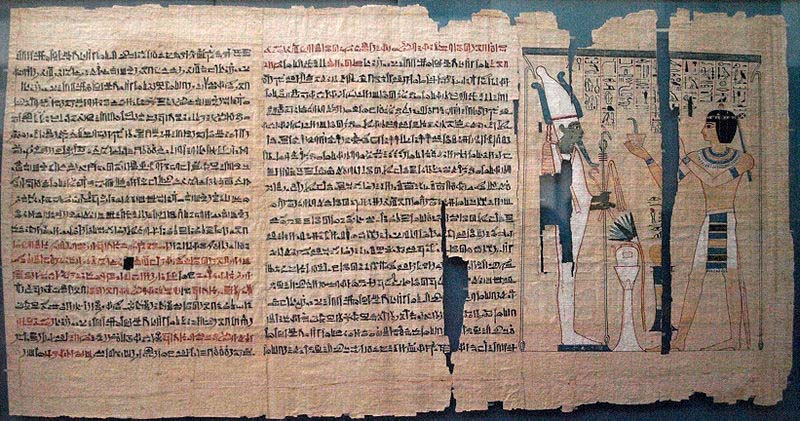

The Book of the Dead is the modern name of an ancient Egyptian funerary text, used from the beginning of the New Kingdom (around 1550 BC) to around 50 BC. The original Egyptian name for the text, transliterated rw nw prt m hrw is translated as "Book of Coming Forth by Day".
Another translation would be "Book of emerging forth into the Light". The text consists of a number of magic spells intended to assist a dead person's journey through the Duat, or underworld, and into the afterlife. The Book of the Dead was part of a tradition of funerary texts which includes the earlier Pyramid Texts and Coffin Texts, which were painted onto objects, not papyrus. Some of the spells included were drawn from these older works and date to the 3rd millennium BC.
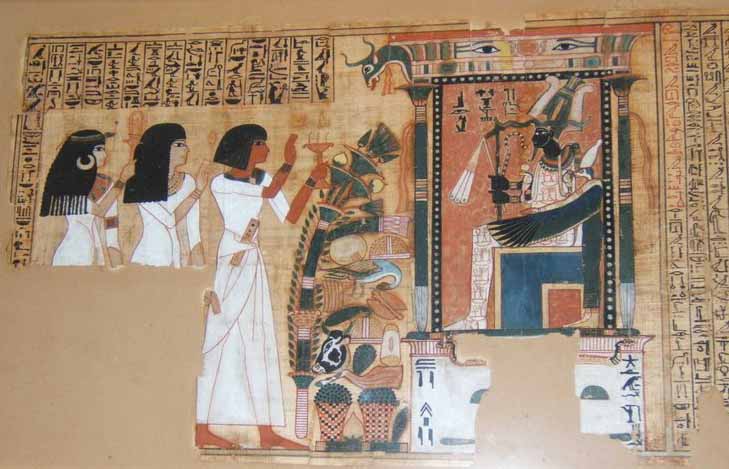
Other spells were composed later in Egyptian history, dating to the Third Intermediate Period (11th to 7th centuries BC). A number of the spells which made up the Book continued to be inscribed on tomb walls and sarcophagi, as had always been the spells from which they originated. The Book of the Dead was placed in the coffin or burial chamber of the deceased.
There was no single or canonical Book of the Dead. The surviving papyri contain a varying selection of religious and magical texts and vary considerably in their illustration. Some people seem to have commissioned their own copies of the Book of the Dead, perhaps choosing the spells they thought most vital in their own progression to the afterlife. The Book of the Dead was most commonly written in hieroglyphic or hieratic script on a papyrus scroll, and often illustrated with vignettes depicting the deceased and their journey into the afterlife.
The spells in the Book of the Dead depict Egyptian beliefs about the nature of death and the afterlife. The Book of the Dead is a vital source of information about Egyptian beliefs in this area.
52-foot-long Book of the Dead papyrus from ancient Egypt discovered at Saqqara Live Science - January 26, 2023
Archaeologists in Egypt have discovered a 52-foot-long (16 meters) papyrus containing sections from the Book of the Dead. The more than 2,000-year-old document was found within a coffin in a tomb south of the Step Pyramid of Djoser at Saqqara. There are many texts from The Book of the Dead, and analysis of the new finding may shed light on ancient Egyptian funerary traditions. Conservation work is already complete, and the papyrus is being translated into Arabic, according to a translated statement (opens in new tab), which was released in conjunction with an event marking Egyptian Archaeologists Day on Jan. 14. This is the first full papyrus to be uncovered at Saqqara in more than 100 years, Mostafa Waziry
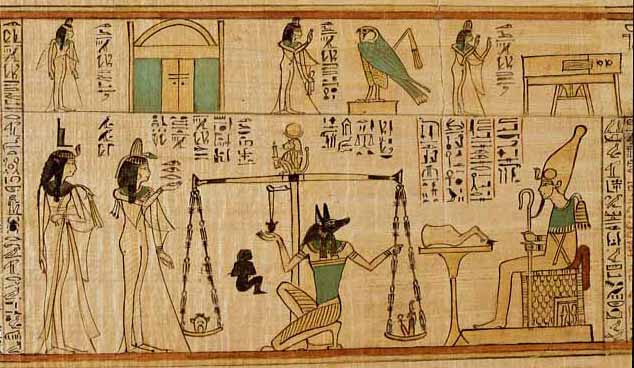
The Book of the Dead developed from a tradition of funerary manuscripts dating back to the Egyptian Old Kingdom. The first funerary texts were the Pyramid Texts, first used in the Pyramid of King Unas of the 5th dynasty, around 2400 BC.
These texts were written on the walls of the burial chambers within pyramids, and were exclusively for the use of the Pharaoh (and, from the 6th dynasty, the Queen). The Pyramid Texts were written in an unusual hieroglyphic style; many of the hieroglyphs representing humans or animals were left incomplete or drawn mutilated, most likely to prevent them causing any harm to the dead pharaoh.
The purpose of the Pyramid Texts was to help the dead King take his place amongst the gods, in particular to reunite him with his divine father Ra; at this period the afterlife was seen as being in the sky, rather than the underworld described in the Book of the Dead. Towards the end of the Old Kingdom, the Pyramid Texts ceased to be an exclusively royal privilege, and were adopted by regional governors and other high-ranking officials.
In the Middle Kingdom, a new funerary text emerged, the Coffin Texts. The Coffin Texts used a newer version of the language, new spells, and included illustrations for the first time. The Coffin Texts were most commonly written on the inner surfaces of coffins, though they are occasionally found on tomb walls or on papyri.
The Coffin Texts were available to wealthy private individuals, vastly increasing the number of people who could expect to participate in the afterlife; a process which has been described as the "democratization of the afterlife".
The Book of the Dead first developed in Thebes towards the beginning of the Second Intermediate Period, around 1700 BC. The earliest known occurrence of the spells included in the Book of the Dead is from the coffin of Queen Mentuhotep, of the 13th dynasty, where the new spells were included amongst older texts known from the Pyramid Texts and Coffin Texts. Some of the spells introduced at this time claim an older provenance; for instance the rubric to spell 30B states that it was discovered by the Prince Hordjedef in the reign of King Menkaure, many hundreds of years before it is attested in the archaeological record.
By the 17th dynasty, the Book of the Dead had become widespread not only for members of the royal family, but courtiers and other officials as well. At this stage, the spells were typically inscribed on linen shrouds wrapped around the dead, though occasionally they are found written on coffins or on papyrus.
The New Kingdom saw the Book of the Dead develop and spread further. The famous Spell 125, the 'Weighing of the Heart', is first known from the reign of Hatshepsut and Tuthmose III, c.1475 BC. From this period onward the Book of the Dead was typically written on a papyrus scroll, and the text illustrated with vignettes. During the 19th dynasty in particular, the vignettes tended to be lavish, sometimes at the expense of the surrounding text.
In the Third Intermediate Period, the Book of the Dead started to appear in hieratic script, as well as in the traditional hieroglyphics. The hieratic scrolls were a cheaper version, lacking illustration apart from a single vignette at the beginning, and were produced on smaller papyri. At the same time, many burials used additional funerary texts, for instance the Amduat.
During the 25th and 26th dynasties, the Book of the Dead was updated, revised and standardized. Spells were consistently ordered and numbered for the first time. This standardized version is known today as the 'Saite recension', after the Saite (26th) dynasty. In the Late period and Ptolemaic period, the Book of the Dead remained based on the Saite recension, though increasingly abbreviated towards the end of the Ptolemaic period. New funerary texts appeared, including the Book of Breathing and Book of Traversing Eternity. The last use of the Book of the Dead was in the 1st century BC, though some artistic motifs drawn from it were still in use in Roman times.

The Book of the Dead is made up of a number of individual texts and their accompanying illustrations. Most sub-texts begin with the word ro, which can mean mouth, speech, a chapter of a book, spell, utterance, or incantation. This ambiguity reflects the similarity in Egyptian thought between ritual speech and magical power. In the context of the Book of the Dead, it is typically translated as either "chapter" or "spell". In this article, the word "spell" is used.
At present, some 192 spells are known, though no single manuscript contains them all. They served a range of purposes. Some are intended to give the deceased mystical knowledge in the afterlife, or perhaps to identify them with the gods: for instance, Spell 17, an obscure and lengthy description of the god Atum.
Others are incantations to ensure the different elements of the dead person's being were preserved and reunited, and to give the deceased control over the world around him. Still others protect the deceased from various hostile forces, or guide him through the underworld past various obstacles. Famously, two spells also deal with the judgement of the deceased in the Weighing of the Heart ritual.
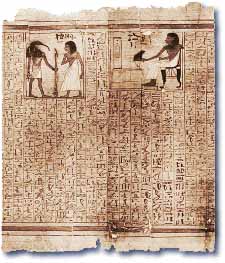
Such spells as 26-30, and sometimes spells 6 and 126 relate to the heart, and were inscribed on scarabs.
The texts and images of the Book of the Dead were magical as well as religious. Magic was as legitimate an activity as praying to the gods, even when the magic was aimed at controlling the gods themselves. Indeed, there was little distinction for the Ancient Egyptians between magical and religious practice.
The concept of magic (heka) was also intimately linked with the spoken and written word. The act of speaking a ritual formula was an act of creation; there is a sense in which action and speech were one and the same thing.
The magical power of words extended to the written word. Hieroglyphic script was held to have been invented by the god Thoth, and the hieroglyphs themselves were powerful. Written words conveyed the full force of a spell.
This was even true when the text was abbreviated or omitted, as often occurred in later Book of the Dead scrolls, particularly if the accompanying images were present. The Egyptians also believed that knowing the name of something gave power over it; thus, the Book of the Dead equips its owner with the mystical names of many of the entities he would encounter in the afterlife, giving him power of them.
The spells of the Book of the Dead made use of several magical techniques which can also be seen in other areas of Egyptian life. A number of spells are for magical amulets, which would protect the deceased from harm. In addition to being represented on a Book of the Dead papyrus, these spells appeared on amulets wound into the wrappings of a mummy.
Everyday magic made use of amulets in huge numbers. Other items in direct contact with the body in the tomb, such as headrests, were also considered to have amulet value. A number of spells also refer to Egyptian beliefs about the magical healing power of saliva.
Almost every Book of the Dead was unique, containing a different mixture of spells drawn from the corpus of texts available. For most of the history of the Book of the Dead there was no defined order or structure. In fact, until Paul Barguet's 1967 "pioneering study" of common themes between texts, Egyptologists concluded there was no internal structure at all. It is only from the Saite period (26th dynasty) onwards that there is a defined order.
The Books of the Dead from the Saite period tend to organize the Chapters into four sections:
Chapters 17-63 Explanation of the mythic origin of the gods and places, the deceased are made to live again so that they may arise, reborn, with the morning sun.
Chapters 64-129 The deceased travels across the sky in the sun ark as one of the blessed dead. In the evening, the deceased travels to the underworld to appear before Osiris.
Chapters 130-189 Having been vindicated, the deceased assumes power in the universe as one of the gods. This section also includes assorted chapters on protective amulets, provision of food, and important places.
One aspect of death was the disintegration of the various kheperu, or modes of existence. Funerary rituals served to re-integrate these different aspects of being. Mummification served to preserve and transform the physical body into a sah, an idealized form with divine aspects; the Book of the Dead contained spells aimed at preserving the body of the deceased, which may have been recited during the process of mummification.
The heart, which was regarded as the aspect of being which included intelligence and memory, was also protected with spells, and in case anything happened to the physical heart, it was common to bury jeweled heart scarabs with a body to provide a replacement.
The ka, or life-force, remained in the tomb with the dead body, and required sustenance from offerings of food, water and incense. In case priests or relatives failed to provide these offerings, Spell 105 ensured the ka was satisfied. The name of the dead person, which constituted their individuality and was required for their continued existence, was written in many places throughout the Book, and spell 25 ensured the deceased would remember their own name.
The ba was a free-ranging spirit aspect of the deceased. It was the ba, depicted as a human-headed bird, which could "go forth by day" from the tomb into the world; spells 61 and 89 acted to preserve it.
Finally, the shut, or shadow of the deceased, was preserved by spells 91, 92 and 188. If all these aspects of the person could be variously preserved, remembered, and satiated, then the dead person would live on in the form of an ankh. An ankh was a blessed spirit with magical powers who would dwell among the gods.
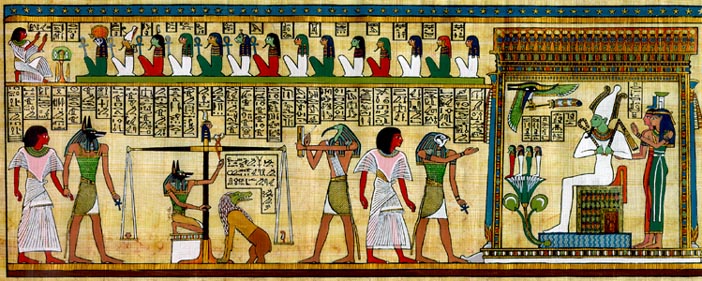
Afterlife
A Book of the Dead papyrus was produced to order by scribes. They were commissioned by people in preparation for their own funeral, or by the relatives of someone recently deceased. They were expensive items; one source gives the price of a Book of the Dead scroll as one deben of silver, perhaps half the annual pay of a laborer. Papyrus itself was evidently costly, as there are many instances of its re-use in everyday documents, creating palimpsests. In one case, a Book of the Dead was written on second-hand papyrus.
Most owners of the Book of the Dead were evidently part of the social elite; they were initially reserved for the royal family, but later papyri are found in the tombs of scribes, priests and officials. Most owners were men, and generally the vignettes included the owner's wife as well. Towards the beginning of the history of the Book of the Dead, there are roughly 10 copies belonging to men for every one for a woman. However, during the Third Intermediate Period, 2/3 were for women; and women owned roughly a third of the hieratic paypri from the Late and Ptolemaic Periods.
The dimensions of a Book of the Dead could vary widely; the longest is 40m long while some are as short as 1m. They are composed of sheets of papyrus joined together, the individual papyri varying in width from 15 cm to 45 cm. The scribes working on Book of the Dead papyri took more care over their work than those working on more mundane texts; care was taken to frame the text within margins, and to avoid writing on the joints between sheets. The words peret em heru, or 'coming forth by day' sometimes appear on the reverse of the outer margin, perhaps acting as a label.
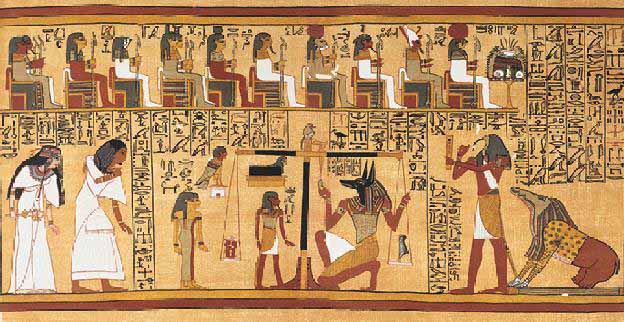
Books were often prefabricated in funerary workshops, with spaces being left for the name of the deceased to be written in later. For instance, in the Papyrus of Ani, the name "Ani" appears at the top or bottom of a column, or immediately following a rubric introducing him as the speaker of a block of text; the name appears in a different handwriting to the rest of the manuscript, and in some places is mis-spelt or omitted entirely.
The text of a New Kingdom Book of the Dead was typically written in cursive hieroglyphs, most often from left to right, but also sometimes from right to left. The hieroglyphs were in columns, which were separated by black lines - a similar arrangement to that used when hieroglyphs were carved on tomb walls or monuments. Illustrations were put in frames above, below, or between the columns of text. The largest illustrations took up a full page of papyrus.
From the 21st Dynasty onward, more copies of the Book of the Dead are found in hieratic script. The calligraphy is similar to that of other hieratic manuscripts of the New Kingdom; the text is written in horizontal lines across wide columns (often the column size corresponds to the size of the papyrus sheets of which a scroll is made up). Occasionally a hieratic Book of the Dead contains captions in hieroglyphic.
The text of a Book of the Dead was written in both black and red ink, regardless of whether it was in hieroglyphic or hieratic script. Most of the text was in black, with red used for the titles of spells, opening and closing sections of spells, the instructions to perform spells correctly in rituals, and also for the names of dangerous creatures such as the demon Apep. The black ink used was based on carbon, and the red ink on ochre, in both cases mixed with water.
The style and nature of the vignettes used to illustrate a Book of the Dead varies widely. Some contain lavish color illustrations, even making use of gold leaf. Others contain only line drawings, or one simple illustration at the opening.
Book of the Dead papyri were often the work of several different scribes and artists whose work was literally pasted together. It is usually possible to identify the style of more than one scribe used on a given manuscript, even when the manuscript is a shorter one. The text and illustrations were produced by different scribes; there are a number of Books where the text was completed but the illustrations were left empty.
The existence of the Book of the Dead was known as early as the Middle Ages, well before its contents could be understood. Since it was found in tombs, it was evidently a document of a religious nature, and this led to the widespread misapprehension that the Book of the Dead was the equivalent of a Bible or Qu'ran.
The first modern facsimile of a Book of the Dead was produced in 1805 and included in the Description de l'Egypte produced by the staff of Napoleon's expedition to Egypt. In 1822, Jean Francois Champollion began to translate hieroglyphic text; he examined some of the Book of the Dead papyri and identified them as a funerary ritual.
In 1842 Karl Richard Lepsius published a translation of a manuscript dated to the Ptolemaic era and coined the name "Book of The Dead". He also introduced the spell numbering system which is still in use, identifying 165 different spells. Lepsius promoted the idea of a comparative edition of the Book of the Dead, drawing on all relevant manuscripts. This project was undertaken by Edouard Naville, starting in 1875 and completed in 1886, producing a three-volume work including a selection of vignettes for every one of the 186 spells he worked with, the variations of the text for every spell, and commentary. In 1876, Samuel Birch of the British Museum published a photographic copy of the papyrus of Nebseny.
The work of E. A. Wallis Budge, Birch's successor at the British Museum, is still in wide circulation - including both his hieroglyphic editions and his English translations, though the latter are now considered inaccurate and out-of-date. More recent translations in English have been published by T. G. Allen (1974) and Raymond O. Faulkner (1972). As more work has been done on the Book of the Dead, more spells have been identified, and the total now stands at 192.
Research work on the Book of the Dead has always posed technical difficulties thanks to the need to copy very long hieroglyphic texts. Initially, these were copied out by hand, with the assistance either of tracing paper or a camera lucida.
In the mid-19th century, hieroglyphic fonts became available and made lithographic reproduction of manuscripts more feasible. In the present day, hieroglyphics can be rendered in desktop publishing software and this, combined with digital print technology, means that the costs of publishing a Book of the Dead may be considerably reduced. However, a very large amount of the source material in museums around the world remains unpublished.